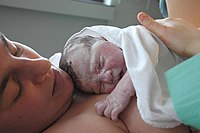
Photo from wikipedia
Introduction and hypothesis Our aim was to examine the effect of the number of catheterizations during labor on the development of overt postpartum urinary retention (PUR) in women who had… Click to show full abstract
Introduction and hypothesis Our aim was to examine the effect of the number of catheterizations during labor on the development of overt postpartum urinary retention (PUR) in women who had a vaginal delivery with epidural anesthesia. Methods A single-center retrospective matched case–control study between 1 January 2015 and 31 December 2016. Women who developed overt PUR were compared with those who did not following a singleton vaginal delivery with epidural anesthesia. For each study two controls, matched for maternal age, gestational age at delivery, and parity, were selected. Each woman’s controls were the immediate subsequent or previous delivery that met matching criteria. Results Two hundred parturients with overt PUR were matched with 400 parturients without overt PUR. In univariate analysis, women with PUR underwent significantly more catheterizations during labor, had an epidural for a longer period of time, and were more likely to have undergone a vacuum-assisted delivery and a mediolateral episiotomy ( p < 0.01 for all). In multivariate analysis controlling for epidural duration, episiotomy, and vacuum-assisted delivery, the risk of PUR among women with at least two catheterizations was greater when fewer catheterizations were performed (OR = 0.78, 95% CI 0.61–0.99). When controlling for the number of catheterizations overall, episiotomy, and vacuum-assisted delivery, PUR risk significantly increased with a longer epidural duration (OR 1.23, 95% CI 1.17–1.29). Episiotomy and vacuum-assisted delivery had no significant effect on PUR. Conclusions The risk of PUR decreases as the number of catheterizations increases. Although longer epidural duration independently increases the risk of PUR, episiotomy and vacuum-assisted delivery do not.
Journal Title: International Urogynecology Journal
Year Published: 2019
Link to full text (if available)
Share on Social Media: Sign Up to like & get
recommendations!